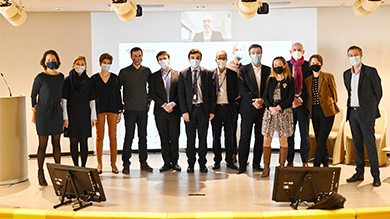The 38 signatory banks of the Collective Commitment to Climate Action (CCCA) have today issued their Year One in Review report, marking the first anniversary of the most ambitious global banking sector initiative supporting the transition to a net-zero economy.
Under the initiative of the UNEP FI (United Nations Environment Programme Finance Initiative), this joint report demonstrates some of the first steps taken by signatory banks over the past 12 months to support the transition to a net-zero economy out to 2050. Natixis is one of the 38 signatories committed to this program – together representing assets of $15 trillion – which is the most ambitious global banking sector initiative to tackle climate change and align with the temperature goals of the Paris Agreement to keep the increase in global temperatures below 2°C as compared with the pre-industrial era.
The report provides an overview of the four key actions taken by Natixis to deliver on its pledge.
Assessing portfolio alignment
The 38 signatory banks have pledged to assess their portfolio alignment on the net-zero goal, and in this respect Natixis has developed a granular taxonomy to evaluate the climate-related impact of all the economic activities it finances, except for the financial sector: 80% of its portfolio is currently assessed. Each transaction is rated on a seven-level scale ranging from negative impact (brown) to positive impact (green). The taxonomy is used as a mandatory and systematic step ahead of credit decisions and monitors the bank’s climate trajectory over the short, medium and long term.
Assessing climate-related transition risks
Signatory banks have pledged to monitor and reduce the climate-related transition risks of their financing business, while engaging and working with clients on their transition. The report presents a case study on Natixis’ Green Weighting Factor (GWF), a unique tool to assess each financing transaction’s climate transition risk that includes an internal capital allocation mechanism that adjusts the amount of internal capital allocated to each transaction depending on its level of transition risk. The bank’s overall exposure is monitored through a Green Weighting Factor indicator included in the Risk Appetite Framework (the share of credit risk weighted assets allocated to the most negatively impactful activities).
Exclusion policies
CCCA signatory banks have also taken a bold commitment to gradually halting funding for sectors that are not compatible with a net-zero economy. In 2020, Natixis strengthened its pre-existing exclusions in the most carbon-intensive sectors. It no longer supports companies that develop any new capacity in coal-powered power generation or thermal coal mining, and therefore aims to be fully withdrawn from the thermal coal sector by 2030 for OECD countries, and 2040 for the rest of the world. Natixis also extended its pre-existing oil & gas exclusion policy, and no longer finances shale oil and gas exploration and production projects worldwide and has pledged to halt financing companies whose activity is reliant by more than 25% on shale oil and gas exploration and production.
Supporting sectors aligned with the Paris Agreement
CCCA signatory banks also pledge to finance sectors that play a key role in the transition to a low-carbon economy. Natixis is one of the leading financiers of renewable energy infrastructure financing worldwide, accounting for 90% of its power generation loan book at end-2019.
This initial report outlines the first steps for this initiative, and CCCA signatory banks have pledged to report annually on their progress. The next key step will be the publication of agreed principles and standards for assessing portfolio alignment with the Paris Agreement in the first quarter of 2021, and we are fully committed to this next stage.














